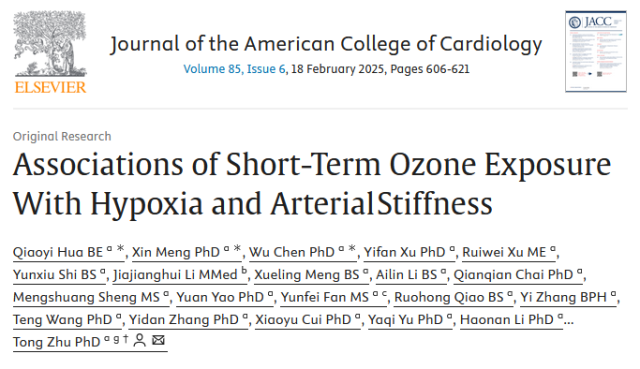

Epidemiological studies reported associations between ozone (O3) exposure and cardiovascular diseases, yet the biological mechanisms remain underexplored. Hypoxia is a shared pathogenesis of O3-associated diseases; therefore, we hypothesized that O3 exposure may induce changes in hypoxia-related markers, leading to adverse cardiovascular effects.
This study aimed to investigate associations of short-term O3 exposure with hypoxic biomarkers and arterial stiffness.
We conducted a panel study involving 210 young healthy residents in 2 cities at different altitudes on the Qinghai-Tibetan Plateau in China, where O3 concentrations are high and particulate pollution is low. Participants underwent 4 repeated visits to assess ambient O3 exposure levels, hypoxic biomarkers, and arterial stiffness. We applied linear mixed-effects models to assess the associations of O3 exposure (lag1 to lag1-7 days) with hypoxic biomarkers and arterial stiffness, adjusted for confounders. Mediation analyses explored the hypoxia’s role in O3-related arterial stiffness changes. We further examined effect modification by residence altitude and the robustness of results by including PM2.5 (particulate matter ≤2.5 μm in aerodynamic diameter) or NO2 in 2-pollutant models.
O3 exposure 1 to 7 days before visits was significantly associated with changes in multiple hypoxic biomarkers. A 10-ppb increase in O3 exposure was linked to significant decreases in oxygen saturation (SpO2) and increases in red blood cell count (RBC), hemoglobin concentration, and hematocrit, with maximum changes by −0.42%, 0.92%, 0.97%, and 1.92%, respectively. Laboratory analysis of mRNA and protein markers consistently indicated that O3 exposure activated the hypoxia-inducible factor 1 (HIF-1) signaling pathway. Additionally, a 10-ppb increase in O3 corresponded to a 1.04% to 1.33% increase in carotid-femoral pulse wave velocity (cfPWV), indicating increased arterial stiffness. RBC, hemoglobin concentration, and hematocrit increases significantly mediated the O3–cfPWV association, whereas the SpO2 reduction had an insignificant mediating effect. Associations of O3 with hypoxic biomarkers varied by altitude. The higher altitude group showed delayed associations with SpO₂ and HIF-1 expression but stronger associations with RBC indices. These associations remained robust after adjusting for copollutants.
O3 exposure may reduce oxygen availability, prompting compensatory increases in red blood cells and hemoglobin, which exacerbate arterial stiffening. These findings provide new insights into the mechanisms underlying O3-induced cardiovascular injury.

https://www.sciencedirect.com/science/article/pii/S0735109724105591